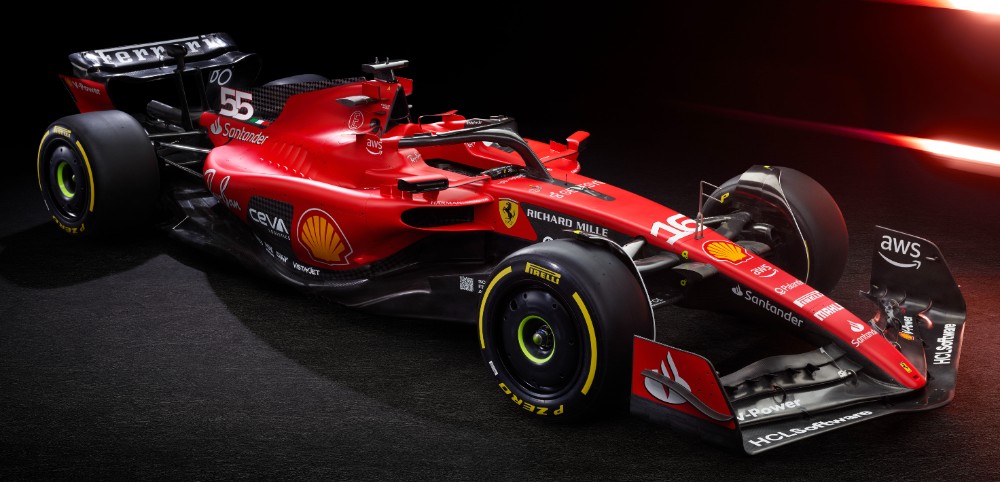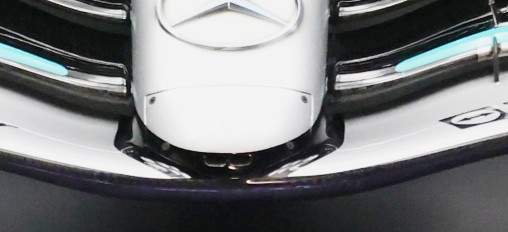
Ferrari launched its 2023 #F1 car yesterday, and ran it for the first time on the Fiorano circuit after the formal launch. Looking over the initial photos I thought I’d share some thoughts and observations in this Tech Thread. #Ferrari #F12023 

Starting at the front Ferrari has changed its nose concept, with the blunter tip no longer meeting the forward most wing element as was the case with the F1-75 (shown for comparison). Instead it joins the second element, while the leading edge has a noticeable dip in the centre. 



The nose tip has a rectangular driver cooling slot, note the small circular fastener below it. There is a pocket for ballast in the centre of the leading edge of the front wing element. The NACA style shape of the F1-75 has been dropped. 





The overall shape of the front wing is interesting with the central section of wing elements much steeper than the outer parts which flatten off dramatically. Something which has been seen on other cars previously. Note the Gurney on the highest section of the upper element 

The front wing endplate features a single S shape dive plane which meets the leading edge of the plate. In 2022 the dive plane stopped short of the leading edge (shown here for comparison - the black version) 





A huge amount of attention has been paid already to the array of slot gap separators sitting between the upper two wing elements and this is not surprising as it was a solution first trialled by Mercedes last year. 

Mercedes fitted oversized slot gap separators in Austin last year, apparently in an attempt to get an out washing effect, but the team removed them ahead of the Mexican Grand Prix. 



It was widely reported that this was because they had been deemed illegal, but F1TV exclusively revealed that the design was never banned, but Mercedes didn’t think it worth the hassle to have the argument. 

The key wording in the rules was that the separators were ‘primarily used for mechanical or structural reasons’, and not ‘solely used for...' . This means parts that resulted in an aerodynamic gain as a secondary outcome were allowed. This interpretation never got tested. 



Some reports stated that this concept was banned in the 2023 rule book - this is not the case. The rules on this part of the car have been revised and the wording suggests devices like this are now legal and not really a matter of dispute (Sam waits for the dispute to start!). 



Ferrari has exploited this change with its array of five separators on each side of the front wing, I’ll be astonished if we don’t see a lot of other teams doing the same. 





The front suspension of the SF-23 remains a pushrod layout, but the geometry has been altered according to the team and the trackrod has been lowered. 

A look at the 2023 front brake ducts. It was a key area of development for many teams last season and probably will be this year too. 

Looking at the cooling system layout on the SF-23 reveals a curious vertical slot below the main sidepod inlet its purpose at the moment remains unclear (I’ll come back to the cooling system further on). 



Mirrors are a big focus for the 2023 season with all cars requiring much larger rear-view mirrors this season, and teams inevitably finding ways to exploit the larger housings in turn. I covered this in a F1TV youtube video a while ago:
Ferrari has interestingly decided to adopt a drag reducing mirror housing, a concept it introduced to the sport and then moved away from. The 2022 car did not feature this concept but did have some other aerodynamic devices added later in the season. (sticky downy bits?) 



An explanation of the drag reducing mirror concept can be found here:
https://mobile.twitter.com/NorthHertsSam/status/1493290907206098952
The general triangular shape of the roll hoop is a direct carry over from the F1-75 but the parts around it are far more elaborate. 



Around the halo and cockpit area there are a number of interesting aerodynamic devices, most of which are evolutions of what was fitted to the F1-75 however the curved elements linking to the rear halo mount are new. As are the small winglets below the drivers name. 



The main sidepod inlet shape is quite similar to that used on the F1-75, though the 2023 version looks a little tighter and more scalloped, note the blister housing the outer edge of the lower side impact structure on the newer car. Suggesting tighter bodywork here. 



The cooling layout of the car appears to be a variation of the concept introduced last season with the same deeply dished sidepod tops returning this year as well. The sidepods though are much less slab sided and seem a fair bit tighter in general than they were in 2022. 



The layout of cooling louvres and outlets has been significantly revised with two distinct sections forward and rearward, a curious centre line cooling outlet has also appeared on the car. Its purpose is not yet clear. The panels are all interchangeable and will likely be swapped 



A comparison of the rear end of the F1-75 and the SF-23 showing how much the cooling layout has changed, it suggests that the layout of coolers under the body may have been revised significantly. 



The floor of the new Ferrari, like all ’23 cars will be a great area of interest and development, at the roll out of the car the floor on display was fairly simple, a more complex floor is expected soon. The floor edge sits 15mm higher than in 2022. 





Looking at the engine cover it seems to drop down more sharply than on the F1-75, suggesting some changes under the bodywork (the Haas is similar). The exposed carbon fibre is to save weight. Its square shape suggests that it is spread tow fabric. 

Ferrari has developed the power unit more than might have been expected during a development freeze, however due to the unreliability of the 066/7 power unit (pictured in a Haas) it has proven possible for Ferrari to develop the PU into the new 066/10 

The changes seem significant with the team admitting to developing the V6 combustion engine and both MGUs. With the reliability improvements performance can also be released so it is expected that the 066/10 has better performance than the 066/7
The rear suspension of the SF-23 remains a pull rod layout as it was in 2022, but there have been some detail changes around the rear of the car, images so far are not really clear yet. 

The SF-23 has already been fitted with two different rear wings, in the studio images the main plane has a flat centre section, but at the Fiorano shakedown a new version with a curved centre section was used. Both have twin supports. 



Think I’ll leave it there for my first impressions of the car, I’ll go into more depth on F1 TV soon. You can sign up here: f1tv.formula1.com
• • •
Missing some Tweet in this thread? You can try to
force a refresh



























